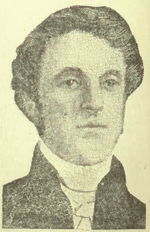Henry Sherwood
| Henry Sherwood | |
|---|---|
|
The Hon. Henry Sherwood | |
| 4th Premier of Canada West | |
|
In office 1846–1850 | |
| Preceded by | William Henry Draper |
| Succeeded by | Robert Baldwin |
| 7th Mayor of Toronto | |
|
In office 1842–1844 | |
| Preceded by | George Monro |
| Succeeded by | William Henry Boulton |
| Personal details | |
| Born |
1807 Augusta Township, Upper Canada |
| Died |
July 7, 1855 (aged 47–48) Bad Kissingen, Bavaria |
| Political party | Tory |
| Spouse(s) | Mary Drite |
| Profession | lawyer, local politician |
Henry Sherwood, Q.C. (1807 – July 7, 1855) was a Canadian lawyer and Tory politician, involved in both provincial and municipal politics. He was appointed Queen's Counsel on 23 January 1838. He served as Mayor of Toronto (1842 to 1844), Solicitor-General of Canada West (1842) and as Joint Premier of the Province of Canada (May 28, 1847 to March 11, 1848). He was also a member of the Orange Order in Canada. He was born in Augusta Township, Upper Canada, and died in Bavaria in 1855 while travelling in Europe.
Provincial Politics
In 1836, Sherwood was elected to the 13th Parliament of Upper Canada representing the town of Brockville. This was the last Parliament of the province of Upper Canada, which in 1841 was united with the province of Lower Canada into the new Province of Canada by the Act of Union 1840, enacted by the British Parliament.
In March 1841, Sherwood stood for election to the new Parliament of the Province of Canada, this time from Toronto, with the Mayor of Toronto, George Monro, as his co-candidate on a Tory ticket. Despite having the full backing of the Orange Order and the conservative establishment, they were defeated in the election by the Reform candidates, Isaac Buchanan and John Dunn. A riot ensued the next day when a victory parade by the Reformers was attacked by Orangemen carrying knives, sticks and firearms. The Orangemen were based at the Coleraine Tavern and had been brought in from Scarborough, Ontario by the tavern's owner, Samuel Sherwood, who happened to be Henry's brother. One man was killed by a shot fired from the tavern.
Charles Dickens, visiting Toronto at the time, observed:
- One man was killed on the same occasion and from the very window whence he received his death, the very flag which shielded his murderer (not only in the commission of his crime, but from its consequences), was displayed again on the occasion of the public ceremony performed by the Governor General, to which I have just adverted. Of all the colours in the rainbow, there is but one which could be so employed: I need not say that the flag was orange.
In 1843, Dunn resigned from the Legislative Assembly to protest Governor Metcalfe's refusal to consult the Executive Council on patronage appointments. In the resulting by-election, Sherwood again stood for election and was successful. He was re-elected to the second Parliament in 1844, and the third Parliament in 1848. He was not originally elected to the fourth Parliament in 1852, but was elected in 1853 in a by-election.
From May 28, 1847 to March 11, 1848, Sherwood served as Joint Premier of the Province of Canada for Canada West along with his counterpart Denis-Benjamin Papineau who represented Canada East.
Municipal Politics
At the same time, Sherwood was involved in municipal politics in Toronto. He was alderman of St. David's Ward when chosen as the seventh Mayor of Toronto from 1842 to 1844, succeeding Munro.
He was a successful mayor. Credit belongs to the committees, but he was the mayor that oversaw the regulation of the market, paving the streets and collecting taxes. In 1842, 94 gas lights illuminated King and Yonge Streets and a waterworks was underway.
Mayor Sherwood saw that the Town Hall was too small for the growing civic government and the plans were drawn for Toronto's first municipal offices. Construction began on the new City Hall (now St. Lawrence Market South) in the summer of 1844 at Jarvis and Front Streets.
Sherwood sat on city council after his final mayoralty term until 1849.
Sherwood's brother and tavern owner, Samuel, would serve as the city's police chief from 1852 to 1859.
Death
He suffered from ill health later in life and died in Bavaria in 1855 while travelling in Europe.
Honors
Elected a member of the American Antiquarian Society in 1844.[1]
References
Mayors of Toronto, Volume 1, 1834 – 1899 by Victor Loring Russell ©1982 Published by: The Boston Mills Press
Used with permission
External links
| Political offices | ||
|---|---|---|
| Preceded by William Henry Draper |
Joint Premiers of the Province of Canada - Canada West 1847–1848 |
Succeeded by Robert Baldwin |

